spaudiopy.decoder
Loudspeaker decoders.
import numpy as np
import matplotlib.pyplot as plt
plt.rcParams['axes.grid'] = True
import spaudiopy as spa
# Loudspeaker Setup
ls_dirs = np.array([[-80, -45, 0, 45, 80, -60, -30, 30, 60],
[0, 0, 0, 0, 0, 60, 60, 60, 60]])
ls_x, ls_y, ls_z = spa.utils.sph2cart(spa.utils.deg2rad(ls_dirs[0, :]),
spa.utils.deg2rad(90-ls_dirs[1, :]))
Functions
|
Loudspeaker signals of All-Round Ambisonic Decoder. |
|
Loudspeaker signals of All-Round Ambisonic Decoder 2. |
|
Loudspeaker gains for All-Round Ambisonic Panning. |
|
Loudspeaker gains for All-Round Ambisonic Panning 2. |
|
Specify a blacklist to exclude simplices from valid simplices. |
|
Barycenter of hull object. |
|
Calculate centroid for each simplex. |
|
Calculate area for each simplex. |
|
Calculate outwards pointing normal for each simplex. |
|
Calculate normal for each vertex from simplices normals. |
Find the characteristic order for specified loudspeaker layout. |
|
|
Return valid simplices, where the aperture form the listener is small. |
|
Return valid simplices for which the listener is inside the hull. |
|
Return valid simplices that point towards listener. |
|
Return valid simplices with all opening angles within simplex > limit. |
|
Loudspeaker signals of Energy-Preserving Ambisonic Decoder. |
Find imaginary loudspeaker coordinates for smoother hull. |
|
|
Wrapper for scipy.spatial.ConvexHull. |
|
Loudspeaker signals of Mode-Matching Ambisonic Decoder. |
|
Magnitude Least-Squares (magLS) binaural decoder. |
|
Loudspeaker gains for nearest loudspeaker selection (NLS) decoding, based on euclidean distance. |
|
Loudspeaker signals of Sampling Ambisonic Decoder. |
|
Spherical Harmonic Domain signals to binaural renderer. |
|
Start the simplices with smallest vertex entry. |
|
Loudspeaker gains for Vector Base Amplitude Panning decoding. |
|
Loudspeaker gains for Vector Base Intensity Panning decoding. |
Classes
|
Creates a 'hull' object containing all information for further decoding. |
- class spaudiopy.decoder.LoudspeakerSetup(x, y, z, listener_position=None)[source]
Bases:
objectCreates a ‘hull’ object containing all information for further decoding.
ls_setup = spa.decoder.LoudspeakerSetup(ls_x, ls_y, ls_z) ls_setup.pop_triangles(normal_limit=85, aperture_limit=90, opening_limit=150) ls_setup.show()
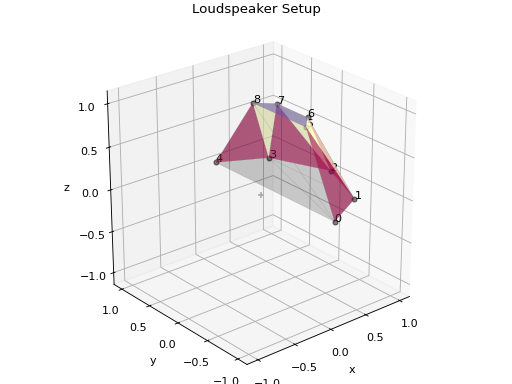
- __init__(x, y, z, listener_position=None)[source]
- Parameters:
x (array_like)
y (array_like)
z (array_like)
listener_position ((3,), cartesian, optional) – Offset, will be substracted from the loudspeaker positions.
- classmethod from_sph(azi, zen, r=1, listener_position=None)[source]
Alternative constructor, using spherical coordinates in rad.
- Parameters:
azi (array_like, spherical)
zen (array_like, spherical)
r (array_like, spherical)
listener_position ((azi, zen, r), spherical, optional) – Offset, will be substracted from the loudspeaker positions.
- is_simplex_valid(simplex)[source]
Tests if simplex is in valid simplices (independent of orientation).
- pop_triangles(normal_limit=85, aperture_limit=None, opening_limit=None, blacklist=None)[source]
Refine triangulation by removing them from valid simplices. Bypass by passing ‘None’.
- Parameters:
normal_limit (float, optional)
aperture_limit (float, optional)
opening_limit (float, optional)
blacklist (list, optional)
- ambisonics_setup(update_hull=False, imaginary_ls=None, characteristic_order=None, N_kernel=50)[source]
Prepare loudspeaker hull for ambisonic rendering. Sets the kernel_hull as an n-design of twice N_kernel, and updates the ambisonic hull with an additional imaginary loudspeaker, if desired.
- Parameters:
update_hull (bool, optional)
imaginary_ls ((L, 3), cartesian, optional) – Imaginary loudspeaker positions, if set to ‘None’ calls ‘find_imaginary_loudspeaker()’ for ‘update_hull’.
characteristic_order (int, optional) – Characteristic Ambisonic order, ‘None’ calls ‘get_characteristic_order()’
N_kernel (int, optional)
Examples
ls_setup.ambisonics_setup(update_hull=True) N_e = ls_setup.characteristic_order ls_setup.ambisonics_hull.show(title=f"Ambisonic Hull, $N_e={N_e}$")
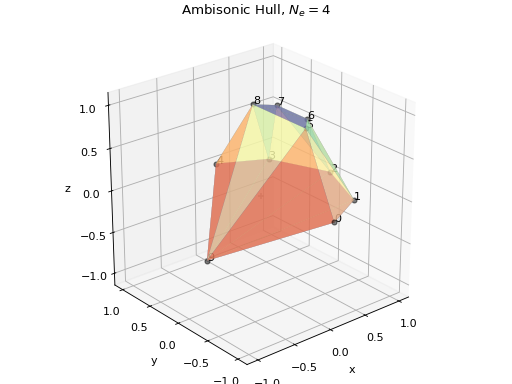
- binauralize(ls_signals, fs, orientation=(0, 0), hrirs=None)[source]
Create binaural signals that the loudspeaker signals produce on this setup (no delays).
- Parameters:
ls_signals ((L, S) np.ndarray) – Loudspeaker signals.
fs (int)
orientation ((azi, zen) tuple, optional) – Listener orientation offset (azimuth, zenith) in rad.
hrirs (sig.HRIRs, optional)
- Returns:
l_sig (array_like)
r_sig (array_like)
- spaudiopy.decoder.calculate_face_normals(hull, eps=1e-05, normalize=False)[source]
Calculate outwards pointing normal for each simplex.
- spaudiopy.decoder.calculate_vertex_normals(hull, normalize=False)[source]
Calculate normal for each vertex from simplices normals.
- spaudiopy.decoder.check_listener_inside(hull, listener_position=None)[source]
Return valid simplices for which the listener is inside the hull.
- spaudiopy.decoder.check_normals(hull, normal_limit=85, listener_position=None)[source]
Return valid simplices that point towards listener.
- spaudiopy.decoder.check_aperture(hull, aperture_limit=90, listener_position=None)[source]
Return valid simplices, where the aperture form the listener is small.
- spaudiopy.decoder.check_opening(hull, opening_limit=135)[source]
Return valid simplices with all opening angles within simplex > limit.
- spaudiopy.decoder.apply_blacklist(hull, blacklist=None)[source]
Specify a blacklist to exclude simplices from valid simplices.
- spaudiopy.decoder.find_imaginary_loudspeaker(hull)[source]
Find imaginary loudspeaker coordinates for smoother hull.
References
Zotter, F., & Frank, M. (2012). All-Round Ambisonic Panning and Decoding. Journal of Audio Engineering Society, Sec. 1.1.
- spaudiopy.decoder.vbap(src, hull, norm=2, valid_simplices=None, retain_outside=False, jobs_count=1)[source]
Loudspeaker gains for Vector Base Amplitude Panning decoding.
- Parameters:
src ((n, 3) numpy.ndarray) – Cartesian coordinates of n sources to be rendered.
hull (LoudspeakerSetup)
norm (non-zero int, float) – Gain normalization norm, e.g. 1: anechoic, 2: reverberant
valid_simplices ((nsimplex, 3) numpy.ndarray) – Valid simplices employed for rendering, defaults hull.valid_simplices.
retain_outside (bool, optional) – Render on the ‘ambisonic hull’ to fade out amplitude.
jobs_count (int or None, optional) – Number of parallel jobs, ‘None’ employs ‘cpu_count’.
- Returns:
gains ((n, L) numpy.ndarray) – Panning gains for L loudspeakers to render n sources.
References
Pulkki, V. (1997). Virtual Sound Source Positioning Using Vector Base Amplitude Panning. AES, 144(5), 357–360.
Examples
ls_setup = spa.decoder.LoudspeakerSetup(ls_x, ls_y, ls_z) ls_setup.pop_triangles(normal_limit=85, aperture_limit=90, opening_limit=150) spa.plot.decoder_performance(ls_setup, 'VBAP') ls_setup.ambisonics_setup(update_hull=True) spa.plot.decoder_performance(ls_setup, 'VBAP', retain_outside=True) plt.suptitle('VBAP with imaginary loudspeaker')
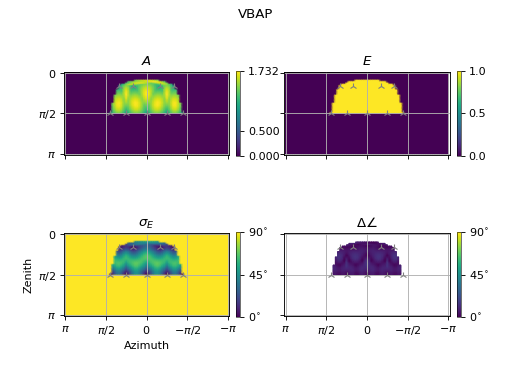
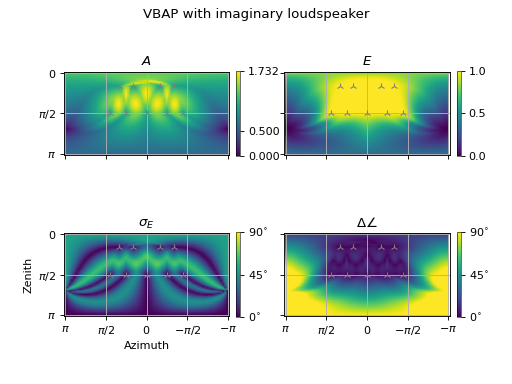
- spaudiopy.decoder.vbip(src, hull, norm=2, valid_simplices=None, retain_outside=False, jobs_count=1)[source]
Loudspeaker gains for Vector Base Intensity Panning decoding.
- Parameters:
src ((n, 3) numpy.ndarray) – Cartesian coordinates of n sources to be rendered.
hull (LoudspeakerSetup)
norm (non-zero int, float) – Gain normalization norm, e.g. 1: anechoic, 2: reverberant
valid_simplices ((nsimplex, 3) numpy.ndarray) – Valid simplices employed for rendering, defaults hull.valid_simplices.
retain_outside (bool, optional) – Render on the ‘ambisonic hull’, amplitude will not fade out with VBIP.
jobs_count (int or None, optional) – Number of parallel jobs, ‘None’ employs ‘cpu_count’.
- Returns:
gains ((n, L) numpy.ndarray) – Panning gains for L loudspeakers to render n sources.
Examples
ls_setup = spa.decoder.LoudspeakerSetup(ls_x, ls_y, ls_z) ls_setup.pop_triangles(normal_limit=85, aperture_limit=90, opening_limit=150) spa.plot.decoder_performance(ls_setup, 'VBIP') ls_setup.ambisonics_setup(update_hull=True) spa.plot.decoder_performance(ls_setup, 'VBIP', retain_outside=True) plt.suptitle('VBIP with imaginary loudspeaker')
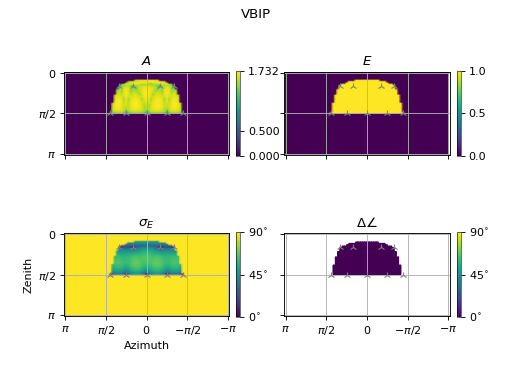
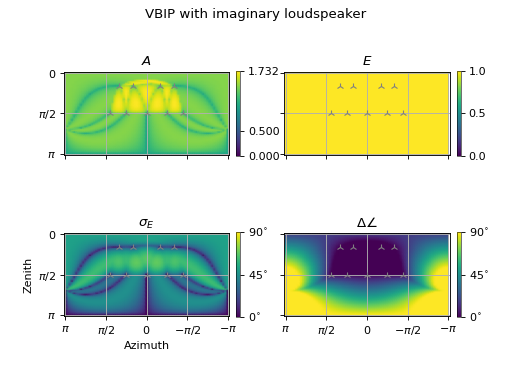
- spaudiopy.decoder.characteristic_ambisonic_order(hull)[source]
Find the characteristic order for specified loudspeaker layout.
References
Zotter, F., & Frank, M. (2012). All-Round Ambisonic Panning and Decoding. Journal of Audio Engineering Society, Sec. 7.
- spaudiopy.decoder.allrap(src, hull, N_sph=None, jobs_count=1)[source]
Loudspeaker gains for All-Round Ambisonic Panning.
- Parameters:
src ((N, 3)) – Cartesian coordinates of N sources to be rendered.
hull (LoudspeakerSetup)
N_sph (int) – Decoding order, defaults to hull.characteristic_order.
jobs_count (int or None, optional) – Number of parallel jobs, ‘None’ employs ‘cpu_count’.
- Returns:
gains ((N, L) numpy.ndarray) – Panning gains for L loudspeakers to render N sources.
References
Zotter, F., & Frank, M. (2012). All-Round Ambisonic Panning and Decoding. Journal of Audio Engineering Society, Sec. 4.
Examples
ls_setup = spa.decoder.LoudspeakerSetup(ls_x, ls_y, ls_z) ls_setup.pop_triangles(normal_limit=85, aperture_limit=90, opening_limit=150) ls_setup.ambisonics_setup(update_hull=True) spa.plot.decoder_performance(ls_setup, 'ALLRAP')
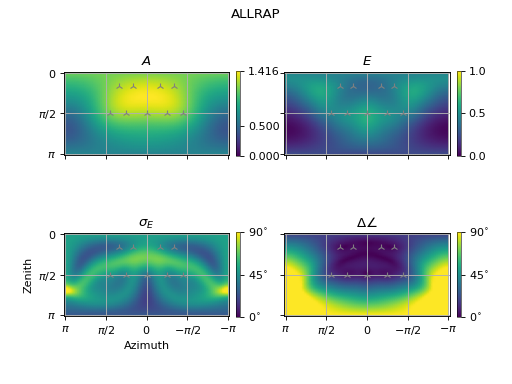
- spaudiopy.decoder.allrap2(src, hull, N_sph=None, jobs_count=1)[source]
Loudspeaker gains for All-Round Ambisonic Panning 2.
- Parameters:
src ((N, 3)) – Cartesian coordinates of N sources to be rendered.
hull (LoudspeakerSetup)
N_sph (int) – Decoding order, defaults to hull.characteristic_order.
jobs_count (int or None, optional) – Number of parallel jobs, ‘None’ employs ‘cpu_count’.
- Returns:
gains ((N, L) numpy.ndarray) – Panning gains for L loudspeakers to render N sources.
References
Zotter, F., & Frank, M. (2018). Ambisonic decoding with panning-invariant loudness on small layouts (AllRAD2). In 144th AES Convention.
Examples
ls_setup = spa.decoder.LoudspeakerSetup(ls_x, ls_y, ls_z) ls_setup.pop_triangles(normal_limit=85, aperture_limit=90, opening_limit=150) ls_setup.ambisonics_setup(update_hull=True) spa.plot.decoder_performance(ls_setup, 'ALLRAP2')
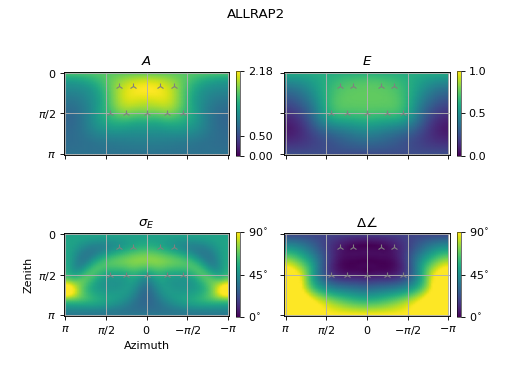
- spaudiopy.decoder.allrad(F_nm, hull, N_sph=None, jobs_count=1)[source]
Loudspeaker signals of All-Round Ambisonic Decoder.
- Parameters:
F_nm (((N_sph+1)**2, S) numpy.ndarray) – Matrix of spherical harmonics coefficients of spherical function(S).
hull (LoudspeakerSetup)
N_sph (int) – Decoding order.
jobs_count (int or None, optional) – Number of parallel jobs, ‘None’ employs ‘cpu_count’.
- Returns:
ls_sig ((L, S) numpy.ndarray) – Loudspeaker L output signal S.
References
Zotter, F., & Frank, M. (2012). All-Round Ambisonic Panning and Decoding. Journal of Audio Engineering Society, Sec. 6.
Examples
ls_setup = spa.decoder.LoudspeakerSetup(ls_x, ls_y, ls_z) ls_setup.pop_triangles(normal_limit=85, aperture_limit=90, opening_limit=150) ls_setup.ambisonics_setup(update_hull=True) spa.plot.decoder_performance(ls_setup, 'ALLRAD')
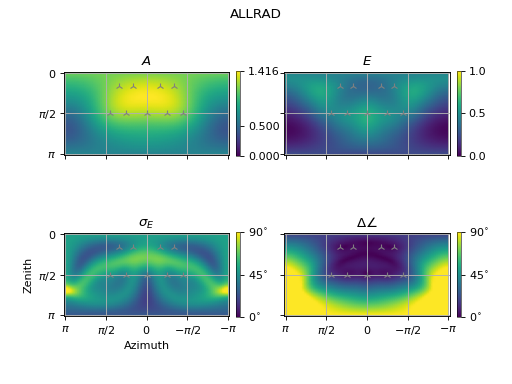
- spaudiopy.decoder.allrad2(F_nm, hull, N_sph=None, jobs_count=1)[source]
Loudspeaker signals of All-Round Ambisonic Decoder 2.
- Parameters:
F_nm (((N_sph+1)**2, S) numpy.ndarray) – Matrix of spherical harmonics coefficients of spherical function(S).
hull (LoudspeakerSetup)
N_sph (int) – Decoding order, defaults to hull.characteristic_order.
jobs_count (int or None, optional) – Number of parallel jobs, ‘None’ employs ‘cpu_count’.
- Returns:
ls_sig ((L, S) numpy.ndarray) – Loudspeaker L output signal S.
References
Zotter, F., & Frank, M. (2018). Ambisonic decoding with panning-invariant loudness on small layouts (AllRAD2). In 144th AES Convention.
Examples
ls_setup = spa.decoder.LoudspeakerSetup(ls_x, ls_y, ls_z) ls_setup.pop_triangles(normal_limit=85, aperture_limit=90, opening_limit=150) ls_setup.ambisonics_setup(update_hull=True) spa.plot.decoder_performance(ls_setup, 'ALLRAD2')
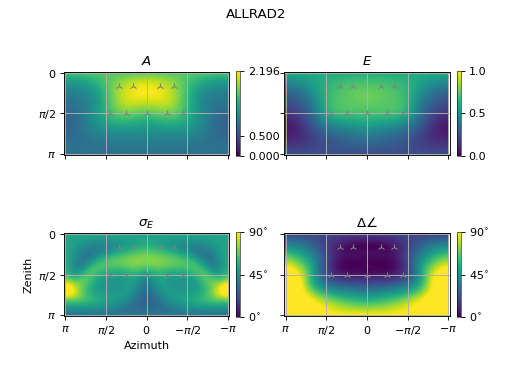
- spaudiopy.decoder.sad(F_nm, hull, N_sph=None)[source]
Loudspeaker signals of Sampling Ambisonic Decoder.
- Parameters:
F_nm (((N_sph+1)**2, S) numpy.ndarray) – Matrix of spherical harmonics coefficients of spherical function(S).
hull (LoudspeakerSetup)
N_sph (int) – Decoding order, defaults to hull.characteristic_order.
- Returns:
ls_sig ((L, S) numpy.ndarray) – Loudspeaker L output signal S.
References
ch. 4.9.1, Zotter, F., & Frank, M. (2019). Ambisonics. Springer Topics in Signal Processing.
Examples
ls_setup = spa.decoder.LoudspeakerSetup(ls_x, ls_y, ls_z) ls_setup.pop_triangles(normal_limit=85, aperture_limit=90, opening_limit=150) spa.plot.decoder_performance(ls_setup, 'SAD')
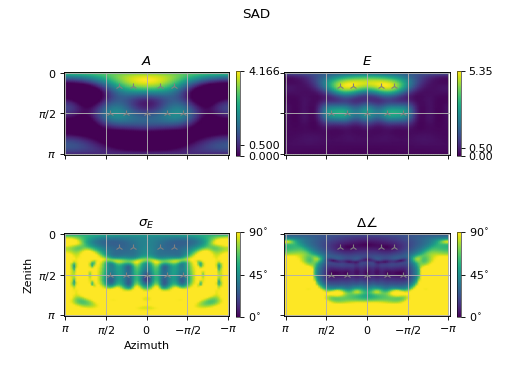
- spaudiopy.decoder.mad(F_nm, hull, N_sph=None)[source]
Loudspeaker signals of Mode-Matching Ambisonic Decoder.
- Parameters:
F_nm (((N_sph+1)**2, S) numpy.ndarray) – Matrix of spherical harmonics coefficients of spherical function(S).
hull (LoudspeakerSetup)
N_sph (int) – Decoding order, defaults to hull.characteristic_order.
- Returns:
ls_sig ((L, S) numpy.ndarray) – Loudspeaker L output signal S.
References
ch. 4.9.2, Zotter, F., & Frank, M. (2019). Ambisonics. Springer Topics in Signal Processing.
Examples
ls_setup = spa.decoder.LoudspeakerSetup(ls_x, ls_y, ls_z) ls_setup.pop_triangles(normal_limit=85, aperture_limit=90, opening_limit=150) spa.plot.decoder_performance(ls_setup, 'MAD')
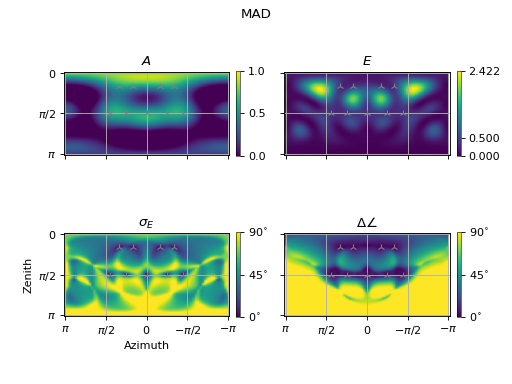
- spaudiopy.decoder.epad(F_nm, hull, N_sph=None)[source]
Loudspeaker signals of Energy-Preserving Ambisonic Decoder.
- Parameters:
F_nm (((N_sph+1)**2, S) numpy.ndarray) – Matrix of spherical harmonics coefficients of spherical function(S).
hull (LoudspeakerSetup)
N_sph (int) – Decoding order, defaults to hull.characteristic_order.
- Returns:
ls_sig ((L, S) numpy.ndarray) – Loudspeaker L output signal S.
Notes
Number of loudspeakers should be greater or equal than SH channels, i.e.
\[L \geq (N_{sph}+1)^2 .\]References
Zotter, F., Pomberger, H., & Noisternig, M. (2012). Energy-preserving ambisonic decoding. Acta Acustica United with Acustica, 98(1), 37–47.
Examples
ls_setup = spa.decoder.LoudspeakerSetup(ls_x, ls_y, ls_z) ls_setup.pop_triangles(normal_limit=85, aperture_limit=90, opening_limit=150) spa.plot.decoder_performance(ls_setup, 'EPAD') spa.plot.decoder_performance(ls_setup, 'EPAD', N_sph=2, title='$N_{sph}=2$')
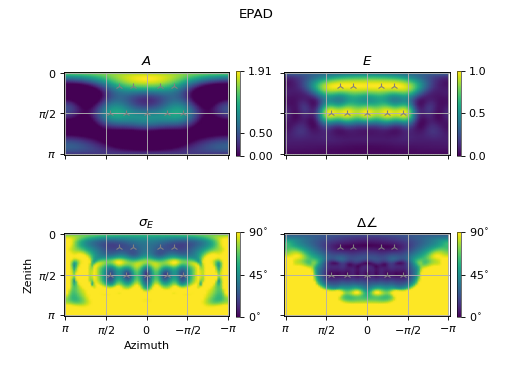
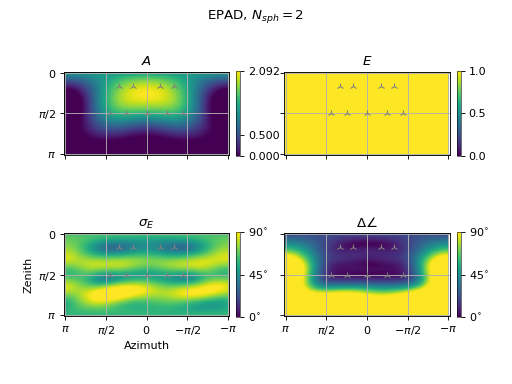
- spaudiopy.decoder.nearest_loudspeaker(src, hull)[source]
Loudspeaker gains for nearest loudspeaker selection (NLS) decoding, based on euclidean distance.
- Parameters:
src ((N, 3)) – Cartesian coordinates of N sources to be rendered.
hull (LoudspeakerSetup)
- Returns:
gains ((N, L) numpy.ndarray) – Panning gains for L loudspeakers to render N sources.
Examples
ls_setup = spa.decoder.LoudspeakerSetup(ls_x, ls_y, ls_z) ls_setup.pop_triangles(normal_limit=85, aperture_limit=90, opening_limit=150) spa.plot.decoder_performance(ls_setup, 'NLS')
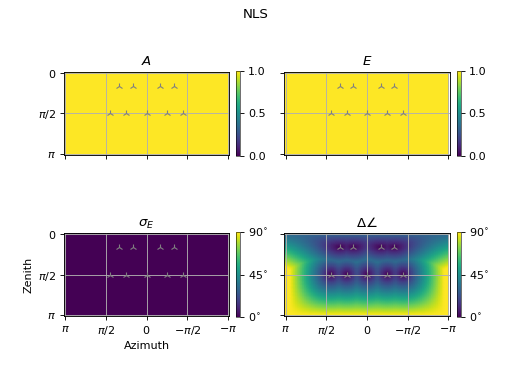
- spaudiopy.decoder.sh2bin(sig_nm, hrirs_nm)[source]
Spherical Harmonic Domain signals to binaural renderer.
Ambisonic signals as N3D - ACN, i.e. real valued SH (time) signals.
- Parameters:
sig_nm (((N_sph+1)**2, S) numpy.ndarray) – Input signal (SHD / Ambisonics).
hrirs_nm ((2, (N_sph+1)**2, L)) – Decoding IRs matrix, 2: left,right (stacked), real coeffs, L taps.
- Returns:
(2, S+L-1) numpy.ndarray – Left and Right (stacked) binaural output signals.
See also
spaudiopy.decoder.magls_bin()MagLS binaural decoder.
- spaudiopy.decoder.magls_bin(hrirs, N_sph, f_trans=None, hf_cont='avg', hf_delay=(0, 0))[source]
Magnitude Least-Squares (magLS) binaural decoder.
This binaural decoder renders the (least squares) binaural output below f_trans, while rendering a magnitude solution above.
- Parameters:
hrirs (sig.HRIRs) – HRIR set.
N_sph (int) – Ambisonic (SH) order.
f_trans (float, optional) – Transition frequency between linear and magLS handling. The default is None, which sets it to ‘N_sph * 500’.
hf_cont ([‘delay’, ‘avg’, ‘angle’], optional) – High Frequency phase continuation method . The default is ‘avg’.
hf_delay ((2,), optional) – High frequency (additional) group delay in smpls. The default is (0, 0).
- Raises:
ValueError – When passing not supported option.
- Returns:
hrirs_mls_nm ((2, (N_sph+1)**2, L)) – Decoding IRs matrix, 2: left,right (stacked), real coeffs, L taps.
Notes
Details can be found in [1]. The iterative procedure in [2] suffers form HF dispersion (available by hf_cont=’delay’ and hf_delay=(0, 0)). This function offers multiple options to mitigate this issue. E.g. manually estimating and setting hf_delay, or estimating a phase difference on previous frequency bins which are then used to predict. This delta can be the spherical average hf_cont=’avg’, which offers an algorithmic way to estimate the global group delay. It can also be estimated per direction when hf_cont=’angle’, which is able to preserve group delay changes over the angle, however, might reintroduce more complexity again. For very low orders, there might be a slight tradeoff.
References
[1] Hold, C., Meyer-Kahlen, N., & Pulkki, V. (2023). Magnitude-Least-Squares Binaural Ambisonic Rendering with Phase Continuation. Fortschritte Der Akustik - DAGA. [2] Zotter, F., & Frank, M. (2019). Ambisonics. Springer Topics in Signal Processing.
See also
spaudiopy.decoder.sh2bin()Decode Ambisonic streams to binaural.